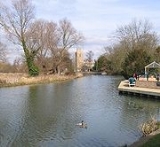
Hemingford Grey
Encyclopedia
Location
It is situated on the southern bank of the River Great OuseRiver Great Ouse
The Great Ouse is a river in the east of England. At long, it is the fourth-longest river in the United Kingdom. The river has been important for navigation, and for draining the low-lying region through which it flows. Its course has been modified several times, with the first recorded being in...
in the county of Cambridgeshire, with the northern bank occupied by the flood meadow. Until 1965 it was in Huntingdonshire
Huntingdonshire
Huntingdonshire is a local government district of Cambridgeshire, covering the area around Huntingdon. Traditionally it is a county in its own right...
and between 1965 and 1974 it was in the short-lived county of Huntingdon and Peterborough
Huntingdon and Peterborough
Huntingdon and Peterborough was a short-lived administrative county in East Anglia in the United Kingdom. It existed from 1965 to 1974, when it became part of Cambridgeshire.-Formation:...
. It adjoins Hemingford Abbots
Hemingford Abbots
Hemingford Abbots is a village in Huntingdonshire , England. The village, almost continuous with neighbouring Hemingford Grey, is situated two miles south west of St Ives.-History:...
to the west and St Ives
St Ives, Cambridgeshire
St Ives is a market town in Cambridgeshire, England, around north-west of the city of Cambridge and north of London. It lies within the historic county boundaries of Huntingdonshire.-History:...
on the north of the river and the A14 trunk road passes through the parish
Parish
A parish is a territorial unit historically under the pastoral care and clerical jurisdiction of one parish priest, who might be assisted in his pastoral duties by a curate or curates - also priests but not the parish priest - from a more or less central parish church with its associated organization...
about a mile south of the main settlement.
History
In Anglo-Saxon times the neighbouring villages of Hemingford Grey and Hemingford AbbotsHemingford Abbots
Hemingford Abbots is a village in Huntingdonshire , England. The village, almost continuous with neighbouring Hemingford Grey, is situated two miles south west of St Ives.-History:...
were a single estate. In the ninth century they were split into two. In 1066 "Little Hemingford", as it was known, was acquired by nearby Ramsey Abbey
Ramsey Abbey
Ramsey Abbey is a former Benedictine abbey located in Ramsey, Cambridgeshire, England, southeast of Peterborough and north of Huntingdon, UK.-History:...
. In around 1140 Payn of Hemingford began the construction of Hemingford Manor
The Manor (Cambridgeshire)
The Manor is a house in the village of Hemingford Grey, Cambridgeshire . It was built in the 1130s and is one of the oldest continuously inhabited houses in Britain — often claimed as the oldest, although this is disputed...
, one of the oldest inhabited buildings in England, as well as the present church. The manor was then owned by the Turberville family who for a while gave their name to the village.
In 1276 the village was given its present name by the de Grey family. The manor remained in the possession of the Greys until seized by Henry VII
Henry VII of England
Henry VII was King of England and Lord of Ireland from his seizing the crown on 22 August 1485 until his death on 21 April 1509, as the first monarch of the House of Tudor....
in the fifteenth century after George Grey, 2nd Earl of Kent
George Grey, 2nd Earl of Kent
George Grey, 2nd Earl of Kent was the son of Edmund Grey, 1st Earl of Kent and Lady Katherine Percy. He was the Second Earl of Kent from 1490 to 1505....
was unable to settle his debts. The manor was subsequently leased to a number of people, including the great-grandfather of Oliver Cromwell
Oliver Cromwell
Oliver Cromwell was an English military and political leader who overthrew the English monarchy and temporarily turned England into a republican Commonwealth, and served as Lord Protector of England, Scotland, and Ireland....
.
Listed as Emingeforde in the Domesday Book, the name Hemingford means "the ford of the people of Hemma or Hemmi", where Hemma is believed to be the name of a Saxon chief. The village was at different times known as East Hemingeford (11th century), Hamicheford (12th), Hemmingeforde Turbervill (13th-14th), Hemmingeforde Parva (13th-14th) and Hemingford Priors (14th-15th).
St James' Church

The spire collapsed during a hurricane in 1741 and instead of being rebuilt was replaced with eight ball finials at its base.
Village life
The centre of the village has an attractive mixture of buildings including thatched timber-framed cottages and the church with its unique truncated spire. Along the riverside path is the Norman Manor House 'The Manor', claimed to be the oldest inhabited house in the United KingdomUnited Kingdom
The United Kingdom of Great Britain and Northern IrelandIn the United Kingdom and Dependencies, other languages have been officially recognised as legitimate autochthonous languages under the European Charter for Regional or Minority Languages...
, where Lucy Boston the children's writer lived and which is open to the public by prior arrangement.
The village is home to a village shop, a primary school, and The Cock public house. The post office closed in 2003, but there is a post office run from St James' Parish Centre. The 19th century Reading Room is still used for community meetings.
Hemingford Grey is a vibrant community with many and varied voluntary organisations providing recreation, education and sporting facilities for residents. Among note is the annual Hemingfords' Regatta, held annually with the adjoining village of Hemingford Abbots since 1901 and believed to be among the oldest village regattas in the country.

